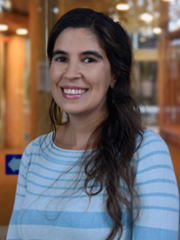Dr Veronica S. Martinez Salazar

Veronica Martinez specialises in mammalian system biology.
Biopharmacuticals are proteins and nucleic acids used for therapeutic or diagnostic purposes, for example vaccines and antibodies. These molecules represent a rapidly growing multi-million dollar market. Mammalian cells are the bio-factories principally used for biopharmaceutical production. However, mammalian cellls culture are expensive due to the media used, respond to stress by apoptosis and have an ineficient metabolism. Therefore, the ultimate goal of my research is to use upstream bioprocess optimization and modelling tools to increase the efficiency of biopharmaceutical production using mammalian cells. A more efficient bioprocess will lead to faster production and lower the production cost, enabling affordability of biopharmaceutical therapies and diagnostics.
Dr Veronica is a is an Advance Queensland Industry Research Fellow. She received her Biotechnology Engineering degree at the University of Chile in 2007, and completed her PhD in Systems Biology at The University of Queensland in 2014. After completing her PhD she performed two years of postdoctoral training at The University of Queensland, as part of a collaboration project with Universidad de Chile. Both Ph.D. studies and postdoctoral training were financially supported by the Chilean Government, under a competitive scholarship and fellowship, respectively. Later she worked as Postdoctoral Research Fellow- Biopharmaceutical Upstream Bioprocessing at the ARC Training Centre for Biopharmaceutical Innovation (CBI), The University of Queensland.
Industry
Her current fellowship project is in partnership with Patheon Biologics by Thermo Fisher.
Collaborations
She has actively collaborated with academia and industry. She collavorated with researchers from the Universidad de Chile and the Universities Space Research Association at NASA Ames Research Center. As well she was part of an international collaboration with the best six groups in the mammalian system biology field to develop the fisrt CHO Genome Scale Model. In her postdoctoral position at CBI and her current fellowship project she works in collaboration with Patheon by Thermo Fisher Scientific.
Funding
Advance Queensland Industry Research Fellowships 2022 Round 5.
Advance Queensland Women's Research Assitance Program (2021-2023)
Global Strategy and Partnerships Seed Funding Scheme Round 1 2017.
Key Publications
Martínez V. S., Saa, P.A. Jooste, J., Tiwari, K., Quek, L. E. and Nielsen, L. K. (2022). The topolgy of genome-scale metabolic reconstruction unravels independent modules and high network flexibility. PLOS Computational Biology, 18(6), e1010203. doi:10.1371/journal.pcbi.1010203
Henry, M. N., MacDonald, M. A., Orellana, C. A., Gray, P. P., Gillards, M., Baker, K., Nielsen, L.K., Marcellin, E., Mahler, S. and Martínez V. S. (2020). Attenuating apoptosis in chinese hamster ovary cells for improved biopharmaceutical production. Biotechnology and Bioengineering, 117 (4), 1187-1203. bit.27269, 1187-1203. doi: 10.1002/bit.27269
Hefzi H, Ang KS, Hanscho M, Bordbar A, Ruckerbauer D, Lakshmanan M, Orellana CA, Baycin-Hizal D, Huang Y, Ley D, Martinez VS, Kyriakopoulos S, Jimenez NE, Zielinski DD, Quek LE, Wulff T, Arnsdorf J, Li S, Lee JS, Paglia G, Loira N, Spahn PN, Pedersen LE, Gutierrez JM, Lund AM, Nagarajan H, Thomas A, Abdel-Haleem AM, Zanghellini J, Kildegaard HF, Voldborg BG, Gerdtzen ZP, Betenbaugh MJ, Palsson BO, Andersen MR, Nielsen LK, Borth N, Lee DY, Lewis NE. (2016) A consensus genome-scale reconstruction of CHO cell metabolism for improved biotherapeutic protein production. Cell Systems, 3(5):434-443.e8.
Martínez V. S., Buchsteiner, M., Gray, P., Nielsen, L. K. and Quek, L. E. (2015) Dynamic metabolic flux analysis using B-splines to study the effects of temperature shift on CHO cell metabolism. Metabolic Engineering Communications, 2 46-57. doi:10.1016/j.meteno.2015.06.001
Martínez V. S., Dietmair S, Quek LE, Hodson MP, Gray P, Nielsen LK. (2013) Flux balance analysis of CHO cells before and after a metabolic switch from lactate production to consumption. Biotechnology and Bioengineering, 110(2):660-666.
| Featured projects | Duration |
|---|---|
| Biopharmaceuticals 4.0: Designing Cell Factories for difficult to express proteins | 2023–2026 |
